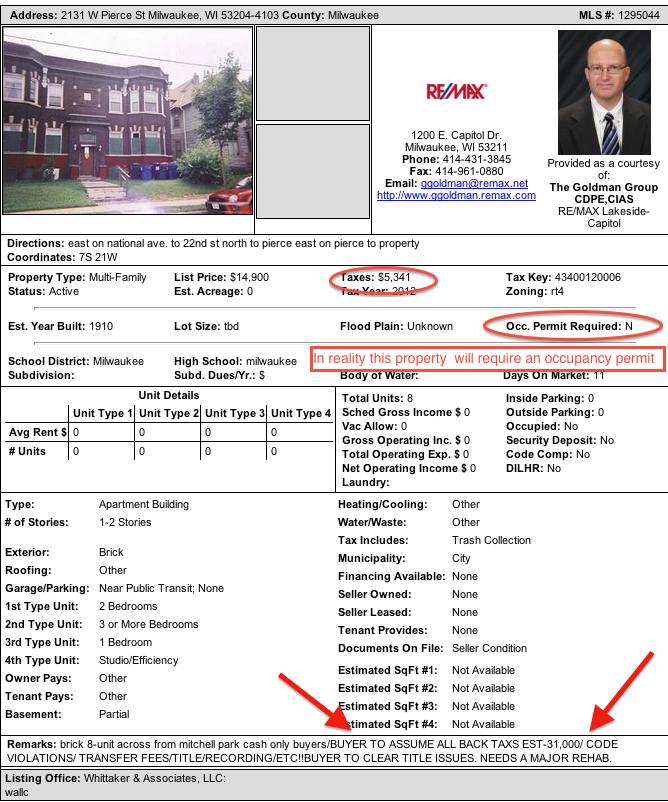Real Estate Ideas for 2013
What can be done collectively to improve our businesses, save costs or generate additional revenue?
On January 1st I posted a list of ideas that I had that some of us could consider to collaboratively work on. I intend to pursue one or two of the ideas presented and may entertain partnering with the right person or persons.
This post is the forth of my more in depth notes on the ideas. I will post others over the next week or so as time permits me to clean my notes into coherent sentences. If any of the topics interest you comment either on the list or directly to me at:Tim@ApartmentsMilwaukee.com
Part Four:
Group purchase of a distressed block or two
There has been this wild idea floating around in my head for years. Long time AASEW member Carl Baryl and I spoke of this many times during the early 90’s. Acquiring a distressed block with a group of active owners and turn it around for fun and profit.
So how would this work?
Choose a very small geo area of Milwaukee. Think something on the terms of both sides of the street for a block or two maybe three at the max. It should be depressed, as in make Detroit look like a nice place to live, depressed. Apologizes to Detroit, but many people know of Detroit’s challenges and fewer of similar challenges of Milwaukee.
Yes, unfortunately, there are many areas like this in Milwaukee and the numbers are increasing as foreclosures work their way through the system.
Oh, you read in the Journal that the foreclosure mess is just about behind us? They may be correct in a overview of SE Wisconsin, but a walk though the neighborhoods will tell a different story in the City of Milwaukee There are actually more, not less properties sitting vacant and obviously abandoned in these areas than when I first wrote about walking the neighborhoods.
A highly visible face block would be best – something that faces the freeway, a school, a major road, shopping area etc.
Then assemble a group of investors to buy the available, preferably vacant & abandoned, properties in the identified area.
This could be done either as a partnership with all owners having an interest in all properties or as an alternative owners would each have individual ownership of their properties, with a homeowner association type mechanism in place as governing bylaws of the project. I am thinking of one standard screening criteria, perhaps a lawn service and other such bundled services.
Partner with a neighborhood group to provide services to the owner occupants. All aspects – crime, trash, maintenance, throw in some owner occupant foreclosure prevention and even some social help.
Then we work our butts off to turn that or those blocks around. Use this as a best practices testbed, putting private, neighborhood and public efforts and resources into a turn around.
Personally, for me to participate the project would have to be on the Southside (8th and 12th Aldermanic Districts) as that is where my interest lay. Others may see areas of the Northside that would offer the biggest bang for the buck.
Choosing the correct first block is very important. There are five potential areas I have in mind today. It would take a bit of work to make a final selection. Considerations would be how many bank and city owned properties ( more the better ) how many rental owners we know and their potential level of cooperation. (again more the better ). My preference would be a neighborhood I currently have a presence in, of course, because there would be an advantage for me. However three of the five target areas I’ve selected are not on blocks that we own houses.
Pretty simple eigh? Of course not.
Doable? Absolutely. Worth the effort? Either yes, or don’t bother doing it. This should result in increase rents, occupancy percentages and resale values.
The outline
Organize the existing property owners; everyone – owner occupants, rentals and commercial properties. Then go at it and buy everything else that is available; vacant land, city owned and banks that are holding etc.
We pitch the idea based on benefit rather than strong arm people to participate. If our initial selection doesn’t result in willing participants we move on to block selection two.
We have our neighborhood group partner find and apply every grant, resource available for both rental owners and the owner occupants in the target area.
The realities of the project
This project would require a lot of work and certainly a bunch of cash as you are not going to typically finance something like this. The City of Milwaukee, despite gaining a benefit from the efforts, will not make it easy. Having bought a bunch of foreclosures over the past couple of years and putting a bunch of effort into making them solid rentals I can attest to some of the pettiness that goes on.
There are success stories in a similar vien.
Bill Doyle of Milwaukee Lead fame did it with northern Bayview. On a larger scale, Tony Goldman in SOHO NY, South Beach and Wynwood, Miami, FL.



